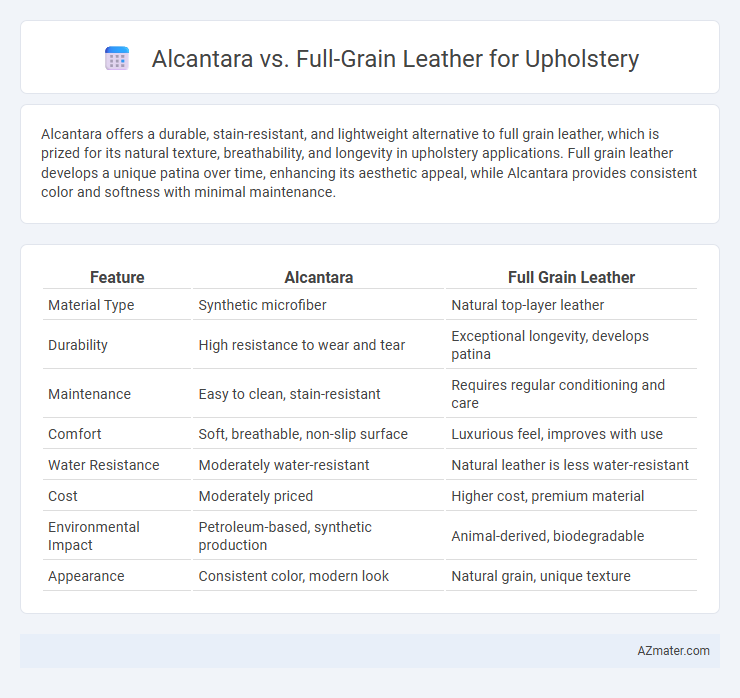Alcantara offers a durable, stain-resistant, and lightweight alternative to full grain leather, which is prized for its natural texture, breathability, and longevity in upholstery applications. Full grain leather develops a unique patina over time, enhancing its aesthetic appeal, while Alcantara provides consistent color and softness with minimal maintenance.
Table of Comparison
| Feature | Alcantara | Full Grain Leather |
|---|---|---|
| Material Type | Synthetic microfiber | Natural top-layer leather |
| Durability | High resistance to wear and tear | Exceptional longevity, develops patina |
| Maintenance | Easy to clean, stain-resistant | Requires regular conditioning and care |
| Comfort | Soft, breathable, non-slip surface | Luxurious feel, improves with use |
| Water Resistance | Moderately water-resistant | Natural leather is less water-resistant |
| Cost | Moderately priced | Higher cost, premium material |
| Environmental Impact | Petroleum-based, synthetic production | Animal-derived, biodegradable |
| Appearance | Consistent color, modern look | Natural grain, unique texture |
Introduction to Alcantara and Full Grain Leather
Alcantara is a durable, synthetic microfiber material known for its suede-like texture, stain resistance, and lightweight nature, making it a popular choice for modern upholstery. Full grain leather, derived from the top layer of animal hide, retains its natural grain, offering superior durability, breathability, and a unique patina that develops over time. Both materials provide distinct benefits, with Alcantara excelling in maintenance and modern aesthetics, while full grain leather delivers timeless luxury and long-lasting strength.
Material Composition: Alcantara vs Full Grain Leather
Alcantara is a synthetic suede alternative made from 68% polyester and 32% polyurethane, offering a soft, durable, and stain-resistant surface ideal for upholstery. Full grain leather, derived from the top layer of animal hide, retains the natural grain and markings, providing superior strength, breathability, and aging character over time. Both materials offer distinct tactile qualities, with Alcantara excelling in uniform texture and Full grain leather praised for its natural, luxurious feel and long-lasting durability.
Aesthetic Appeal and Texture Differences
Alcantara offers a soft, suede-like texture with a matte finish, providing a modern and luxurious aesthetic ideal for contemporary upholstery designs. Full grain leather boasts a natural, rich patina with visible grain patterns that enhance over time, contributing to a classic and timeless appearance. The tactile experience of Alcantara is smooth and uniform, while full grain leather offers a more varied texture that emphasizes durability and character.
Durability and Longevity Comparison
Full grain leather offers superior durability and longevity for upholstery due to its natural grain structure, resistance to wear, and ability to develop a rich patina over time. Alcantara, a synthetic microfiber material, provides good durability with its resistance to stains and fading but generally lacks the long-term resilience and aging characteristics of full grain leather. For high-traffic furniture, full grain leather remains the preferred choice for lasting strength and timeless appeal.
Comfort and Sensory Experience
Alcantara offers a soft, suede-like texture that provides a warm, plush feel, enhancing comfort in upholstery with its breathable and lightweight properties. Full grain leather delivers a firm, natural texture that becomes more supple over time, offering a luxurious sensory experience with its unique grain and durability. The choice between Alcantara and full grain leather ultimately depends on preference for a velvet-like softness versus an authentic, evolving leather touch.
Maintenance and Cleaning Requirements
Alcantara upholstery offers superior stain resistance and easy cleaning with mild soap and water, making it ideal for low-maintenance environments, while full grain leather requires regular conditioning to prevent cracking and maintains longevity through specialized leather cleaners. Alcantara's synthetic microfiber resists fading and does not absorb liquids as quickly as full grain leather, which needs prompt wiping of spills to avoid permanent stains. Full grain leather develops a natural patina over time with proper care, enhancing its appearance but demanding more meticulous upkeep compared to Alcantara's consistent texture and color retention.
Environmental Impact and Sustainability
Alcantara, a synthetic microfiber made primarily from polyester and polyurethane, offers a more sustainable option than full grain leather by reducing animal exploitation and minimizing water and chemical usage in production. Full grain leather, derived from animal hides, involves resource-intensive processes including livestock farming, which significantly contribute to greenhouse gas emissions and deforestation. Choosing Alcantara for upholstery supports lower environmental impact through its recyclable properties and longer lifecycle, contrasting with the higher ecological footprint associated with traditional leather tanning and waste.
Cost Analysis: Alcantara vs Full Grain Leather
Alcantara offers a cost-effective alternative to full grain leather, often priced 30-50% lower due to its synthetic production process. Full grain leather demands a higher investment because of its natural origin, durability, and labor-intensive tanning methods. When evaluating upholstery expenses, consider material longevity and maintenance costs, as full grain leather typically outlasts Alcantara, potentially offsetting the upfront price difference over time.
Applications in Automotive and Furniture Upholstery
Alcantara offers superior stain resistance, lightweight durability, and a suede-like texture ideal for automotive interiors, enhancing comfort and luxury while minimizing maintenance. Full grain leather provides unmatched longevity, natural breathability, and a classic aesthetic favored in premium furniture upholstery, delivering a rich patina and robust wear over time. Both materials serve critical roles in automotive and furniture applications, with Alcantara preferred for modern, high-performance environments and full grain leather chosen for timeless elegance and durability.
Conclusion: Choosing the Right Upholstery Material
Alcantara offers a modern, stain-resistant, and low-maintenance option ideal for high-traffic areas and contemporary designs, while full grain leather provides unmatched durability, a natural aesthetic, and develops a rich patina over time, making it perfect for traditional and luxury interiors. Selecting between Alcantara and full grain leather depends on factors like budget, desired texture, maintenance commitment, and long-term wear resistance. For longevity and classic appeal, full grain leather excels, whereas Alcantara suits spaces requiring easy care and a sleek, modern look.

Infographic: Alcantara vs Full Grain Leather for Upholstery
 azmater.com
azmater.com